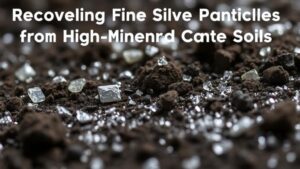How to Process and Smelt Gold Concentrates at Home Safely
How to Process and Smelt Gold Concentrates at Home Safely
Processing and smelting gold concentrates may sound daunting, but with the right knowledge and precautions, it can be done safely at home. This article aims to provide a comprehensive guide to the methods, equipment, and safety measures necessary for processing and smelting gold concentrates effectively. By understanding these elements, you can embark on this rewarding venture with confidence.
Understanding Gold Concentrates
Gold concentrates are the result of the extraction process from ore, often containing a higher purity of gold alongside other materials. Understanding what constitutes a gold concentrate is essential for the processing and smelting stages.
- Gold particles are often mixed with other minerals and materials such as iron, copper, and silica.
- Concentrates can be obtained from various methods including panning, sluicing, or during commercial mining operations.
Necessary Equipment and Materials
Before beginning the processing and smelting of gold concentrates, have the following equipment and materials on hand:
- Crucible: Used to melt the gold.
- Furnace or propane torch: Necessary for achieving high temperatures.
- Boric acid and soda ash: Used as flux to purify the gold.
- Personal protective equipment (PPE): Gloves, goggles, and masks to protect against fumes and heat.
- Molds: For casting the molten gold into ingots or desired shapes.
Safety Precautions
Safety is paramount when processing and smelting gold at home. Follow these guidelines:
- Always work in a well-ventilated area to avoid fume inhalation.
- Use appropriate PPE to protect against burns and inhalation of hazardous substances.
- Keep flammable materials away from the work area.
- Be aware of emergency procedures in case of accidents or equipment failure.
Processing Gold Concentrates
Step 1: Crushing and Grinding
Begin by crushing and grinding the gold concentrates to liberate the gold particles from other materials. This can involve:
- Using a hammer mill or ball mill for crushing the ore.
- Sieving the crushed material to obtain a fine powder.
Empirical data has demonstrated that finer particles yield a higher recovery of gold.
Step 2: Concentration
Next, separate the gold from other minerals through a concentration process. Common techniques include:
- Using a sluice box to wash away lighter materials while retaining heavier gold particles.
- Utilizing a gold pan to manually isolate gold from other sediments.
Smelting Gold Concentrates
Step 3: Preparing for Smelting
Once concentrated, prepare to smelt the gold concentrate:
- Combine gold concentrate with flux materials like boric acid and soda ash in a crucible.
- Ensure that the mixture is homogenous for the best results.
Step 4: Heating and Melting
Using a furnace or a propane torch, apply heat to the crucible:
- Heat the mixture to around 1100-1600 degrees Celsius (2000-2900 degrees Fahrenheit).
- Monitor the process carefully to avoid overheating and damaging the gold.
Step 5: Casting the Gold
Once the gold is molten, pour it into prepared molds:
- Allow the gold to cool and solidify into ingots.
- Once cooled, the ingots can be further refined or polished as desired.
Conclusion and Actionable Takeaways
Processing and smelting gold concentrates at home is a doable, albeit complex, task that requires careful planning and adherence to safety protocols. By crushing, grinding, and subsequently smelting with proper techniques and equipment, you can successfully produce high-purity gold.
For those interested in pursuing this process, consider the following actionable takeaways:
- Ensure you are knowledgeable about the methods and possess the right equipment.
- Always prioritize safety by using PPE and working in a ventilated area.
- Reinforce learning with hands-on practice, starting with small batches before scaling up.
With the right preparation and attention to detail, you can engage in the rewarding hobby of gold processing and smelting at home.



